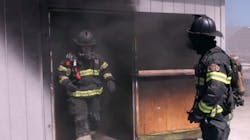Manufacturer's Corner: What We Can Do to Reduce Cancer Risks
Manufacturers’ Corner content is sponsored by manufacturers and suppliers serving the fire service industry.
Firefighting is dangerous. Everyone appreciates the perils of this valiant profession and the bravery our everyday heroes exhibit each time they run into a burning building.
What everyone hadn’t understood until more recently, however, was the fact firefighters face an additional threat beyond flames, smoke, and heat. That threat is cancer, which is now considered the No. 1 killer of firefighters, according to the International Association of FireFighters. This alarming news is supported by the fact that over the past decade, more than 60 percent of the names added to the IAFF Fallen Fire Fighter Memorial have died from occupational cancer. Leukemia, lymphoma, and myeloma are some of the most common killers among firefighters.
At TargetSolutions, our customers often seek guidance on how to lower their risk profiles. Without question, training is critical. But this goes deeper than training. This goes to the culture of every fire department. To reduce cancer rates, the fire service needs to change longstanding traditions and mindsets around proper utilization and maintenance of turnout gear, as well as post-incident hygiene and exercise, among other things.
Many departments have recognized the need to this type of change and are now spreading the word and enforcing policies that mandate awareness and compliance with this shift in culture.
Firefighting Increases Cancer Risk
The good news is that widely-circulated numbers are not accurate. For example, some sources have erroneously reported that firefighters are 250 percent more likely than the general population to develop cancer. Fortunately, this is inaccurate. A CDC/National Institute for Occupational Safety and Health report posted in 2017 says firefighters have a 9 percent greater chance of being diagnosed with cancer and a 14 percent higher chance of dying from this disease than the rest of the population.
TargetSolutions is a strong advocate for identifying ways to minimize the cancer risk for firefighters. Training is essential, but it’s also crucial for fire departments to enforce rules and provide constant reminders of how sensible precautions can make a difference. This often requires overhauling old traditions. For example, firefighters have long promoted the image of fighting fires with soot on their faces and gear. Similarly, firefighters are often anxious to remove their masks and breathe in fresh air after fighting a fire, overlooking the dangers of lingering smoke.
Of course, these habits were developed before it was known how risky they could be – but today, it’s crucial for firefighters to thoroughly decontaminate themselves as soon as possible after fighting fires. The responsibility to educate personnel falls on the departments that are employing them.
Educating Firefighters on How to Reduce Their Risk
Having top-quality equipment is the first line of defense for firefighters, not only against fires but also against cancer. But when the gear isn’t thoroughly cleaned, toxic residues can remain. The National Fire Protection Association publishes the NFPA 1851, Standard on Selection, Care, and Maintenance of Protective Ensembles for Structural Fire Fighting and Proximity Fire Fighting. This is the recognized standard on how to care for personal protective equipment.
Critical precautionary measures include firefighters having PPE and SCBA on completely before entering and after exiting any fire, using wet naps to remove soot from the face and neck immediately upon exit, showering within an hour of an incident, properly cleaning gear on a regular basis, and working out within 24 hours of an incident to expedite chemicals through sweat. Awareness of these precautions can save lives.
To make this information more accessible, TargetSolutions released a training course last year that covers the material in NFPA 1851. Beginning in September, to continue its commitment in helping prevent cancer-related risks due to firefighting, TargetSolutions’ NFPA 1851 – Cancer-Related Risks of Firefighting course will be made available for free through December. For every course completion, TargetSolutions will donate $1 up to a total of $5,000 to the American Cancer Society, with the complete donation being made in January 2020.
As we learn more about the cancer risks for firefighters, it’s important to continue to provide helpful information, like the training course we are making free of charge for members of the fire service, to help educate these everyday heroes in every way possible. This comes down to education, having the right equipment, and making sure that safety protocols are followed. After all, what good is a policy if it’s not enforced? Firefighters’ lives are at risk every day simply by doing their jobs. The least we can do is help to minimize their risk of developing deadly diseases. TargetSolutions is committed to helping firefighters stay safe and healthy.

Marc Scheipe
Marc Scheipe serves as Executive Vice President of TargetSolutions, which is the public sector business unit of eLearning and performance support software leader Vector Solutions. Prior to working at Vector Solutions, Scheipe oversaw Sage Software as President, North America. He holds an MBA from Harvard Business School and is a distinguished graduate of the U.S. Naval Academy. While serving in the Navy, Scheipe attained the rank of lieutenant commander and held various roles in operations, training, and maintenance during a 10-year military career. Scheipe is a TOPGUN graduate and FA-18 strike/fighter pilot with more than 1,800 flight hours.







